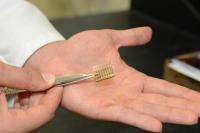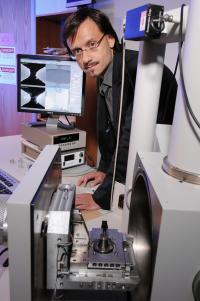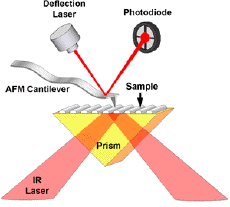Science
In-sync Brain Waves Hold Memory of Objects Just Seen

brain visual working memory circuit holds information in mind about what has just been seen. It represents the memory and distinguishes among objects via unique patterns of brain wave synchronization between neurons in the circuit. For example, two distant hubs in the circuit, one at the front of the brain (right circle) and the other at the rear side (left circle), showed varying amounts of synchrony in their brain waves, depending on what object a monkey was holding in memory. The coherence of synchronous activity between cells in these regions was plotted for different objects the monkey saw over several trials. The large area of red in the lowest graph indicates that the brain waves in the two regions were highly in-sync after seeing a particular object – indicating that they were highly involved in holding in short-term memory information about that object. The modest amount of red for the top graph indicates lesser involvement for another object. By contrast, lack of red in the middle graph shows that the two groups of neurons weren’t much involved in remembering a third object. So the memory of any particular object appears to be represented by its own unique mix of neurons oscillating in-sync.
- Read more
- 376 reads
A Hint of Hawaii in the Sands of Mars

The first x-ray crystallography view of Martian soil. Obtained by the Chemistry and Mineralogy (CheMin) experiment on NASA's Curiosity rover, these data reveal crystalline feldspar, pyroxenes and olivine mixed with some amorphous (non-crystalline) material. The soil sample is similar to volcanic soils in Hawaii.
- Read more
- 363 reads
Folding Funnels Key to Biomimicry: Berkeley Lab Finding that Protein Folding Funnels Also Apply to Self-Assembly Should Benefit Biomimicry and Nanosynthesis

AFM micrograph of 2D S-layers assembled on mica shows two different pathways to crystalization, one in which the domans are 2-3 nanometers taller (white circles). Height differences, measured along the dotted black line, were the result of kinetic trapping.
- Read more
- 464 reads
Stanford scientists build the first all-carbon solar cell

This shows the new all-carbon solar cell consists of a photoactive layer, which absorbs sunlight, sandwiched between two electrodes.
- Read more
- 408 reads
Dust's Warming Counters Half of its Cooling Effect

Before (left) and after (right) photos of the study site in Zhangye, China, show the magnitude of the May 2008 dust event.
- Read more
- 457 reads
Low-resistance connections facilitate multi-walled carbon nanotubes for interconnects: Hybrid electronics

Georgia Tech Professor Andrei Fedorov demonstrates the electron beam induced deposition (EBID) system used to create graphitic nanojoints to multi-walled carbon nanotubes.
- Read more
- 375 reads
NIST research highlights promise of AFM-IR for quantitative nanoscale chemical analysis

Schematic to show the operation of AFM-IR
- Read more
- 373 reads
NASA Lunar Scientists Develop New Theory on Earth and Moon Formation

New research funded by NLSI theorizes that our early Earth and moon were perhaps created in a different manner than has previously been believed.
- Read more
- 357 reads
NASA Rover's First Soil Studies Help Fingerprint Martian Minerals

First X-ray View of Martian Soil
This graphic shows results of the first analysis of Martian soil by the Chemistry and Mineralogy (CheMin) experiment on NASA's Curiosity rover. The image reveals the presence of crystalline feldspar, pyroxenes and olivine mixed with some amorphous (non-crystalline) material. The soil sample, taken from a wind-blown deposit within Gale Crater, where the rover landed, is similar to volcanic soils in Hawaii. The colors in the graphic represent the intensity of the X-rays, with red being the most intense.
- Read more
- 369 reads
Human Rights
Fostering a More Humane World: The 28th Eurasian Economic Summi

Conscience, Hope, and Action: Keys to Global Peace and Sustainability

Ringing FOWPAL’s Peace Bell for the World:Nobel Peace Prize Laureates’ Visions and Actions

Protecting the World’s Cultural Diversity for a Sustainable Future

Puppet Show I International Friendship Day 2020


